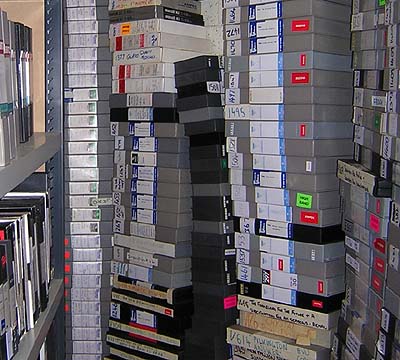
Long-Term Digital Dilemma
The New York Times and the Hollywood Reporter both have recently written about a new 74-page report from the Academy of Motion Picture Arts and Sciences called “The Digital Dilemma: Strategic Issues in Archiving and Accessing Digital Motion Picture Materials” (not yet online).
The paper addresses a perennial Long Now concern: the ephemeral nature of digital preservation. How digital media are short lived, and liable for early extinction. There are some new and interesting facts suggested by the reports. In a December 23, 2007 article called “The Afterlife is Expensive for Digital Movies” the Times claims that the crux of the preservation dilemma is that analog, while less desirable is much cheaper: “To store a digital master record of a movie costs about $12,514 a year, versus the $1,059 it costs to keep a conventional film master.”

The solution? Preserve all movies, including all movies shot in digital, onto analog film. The Times says: “At present, a copy of virtually all studio movies — even those like “Click” or “Miami Vice” that are shot using digital processes — is being stored in film format, protecting the finished product for 100 years or more.”
However, if analog storage was so great, we would not have lost so many films to decaying or exploding celluloid film. According to the Times, in terms of survival rates, analog storage is not much better than digital. It says “only half of the feature films shot before 1950 survive.”
But the questions and concerns about digital storage are still very much unknown. The Times again:
To begin with, the hardware and storage media — magnetic tapes, disks, whatever — on which a film is encoded are much less enduring than good old film. If not operated occasionally, a hard drive will freeze up in as little as two years. Similarly, DVDs tend to degrade: according to the report, only half of a collection of disks can be expected to last for 15 years, not a reassuring prospect to those who think about centuries. Digital audiotape, it was discovered, tends to hit a “brick wall” when it degrades. While conventional tape becomes scratchy, the digital variety becomes unreadable.
Hollywood is finally waking up to the worry.
Milt Shefter, the project leader on the AMPAS Science and Technology Council’s digital motion picture archival project, is quoted in The Hollywood Reporter article as follows:
“We are already heading down this digital road … and there is no long-term guaranteed access to what is being created. We need to understand what the consequences are and start planning now while we still have an analog backup system available.” … Shefter noted that a requirement for any preservation system is that it must meet or exceed the performance characteristic benefits of the current analog photochemical film system. According to the report, these benefits include a worldwide standard; guaranteed long-terms [sic] access (100-year minimum) with no loss in quality; the ability to create duplicate masters to fulfill future (and unknown) distribution needs and opportunities; and immunity from escalating financial investment.
Join our newsletter for the latest in long-term thinking
Subscribe